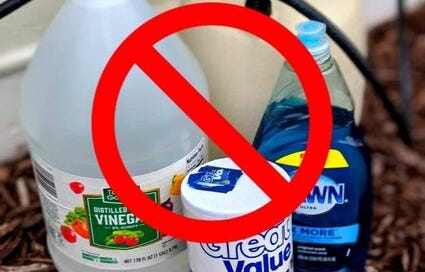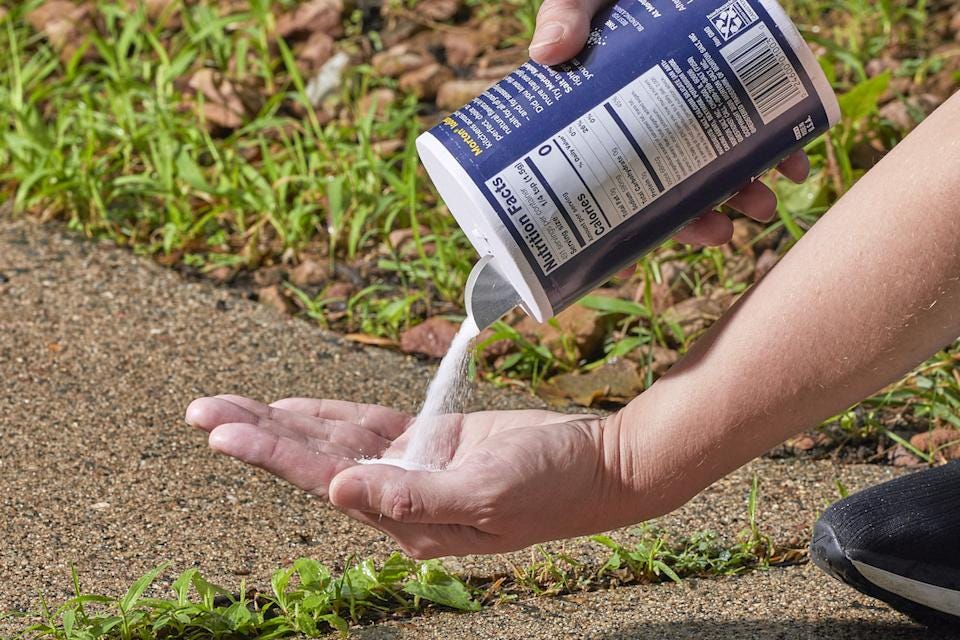DOES VINEGAR + EPSOM SALTS + DISH SOAP = NATURAL HERBICIDE?
A Closer Look at a Popular Homemade Weed Killer
This weed-killing recipe pops up constantly on social media pages devoted to gardening. There’s some logic behind the concoction. The acid of the vinegar can, when applied at the right concentration (“horticultural grade”), burn plants. The dish soap, as a surfactant, helps the vinegar stick. The Epsom salts, well, hmmm.
“Agricultural/horticultural vinegar” has about four times the acetic acid of the vinegar we use in the kitchen. At 20 percent acetic acid, “horticultural vinegar” is dangerous enough that users are cautioned to wear long sleeves, gloves, and goggles to protect themselves from burns and splashes. In addition to being damaging to the skin and a serious irritant to the eyes, it can damage the mucous membranes of the nose and throat (the smell, to say the least, is unpleasant), and it is corrosive. At its worst, repeated exposure may cause dermatitis, chronic bronchitis, and erosion of teeth. Hence why most states require registration for use of acetic acid as a pesticide.
At this concentration, by the way, it is no longer “vinegar” in the sense that we know it. For commercial use, acetic acid (also known as ethanoic acid) is almost always produced synthetically (carbonylation of methanol), rather than by bacterial fermentation, the natural process for vinegars.
It’s not registered for home use on weeds (nor on salads), hence not legally sold nor recommended for such. Household vinegar (as illustrated) and any acetic acids of 8 percent or less inert ingredient are exempt from registration by the EPA as a pesticide.
Equipment used to spray such “vinegar” must be cleaned after application, particularly metal equipment. Equipment with metal working parts, such as metal spray lines or metal nozzles, are particularly vulnerable to corrosion. Also vulnerable: reactive metals such as aluminum, tin, iron, and items such as fencing or lawn furniture; even masonry sidewalks and structures are subject to staining, mottling, or etching.
As with other heavy-duty herbicides, drifting acetic acid spray may damage desirable plants, both yours and those of your neighbors.
Although it contains hydrogen and carbon atoms (the definition of “organic”), horticultural vinegar is not an “organic” product in the sense of gardening as such. Many chemists have said horticultural vinegar (a chemical) is more toxic to humans than common weedkillers. Maybe most importantly, this concentration of acid does damage soil life.
The dish soap helps spread the other ingredients better (it’s a surfactant that breaks down the surface tension of the water droplets) and it does dry out the leaves of the plant (the soap dissolves the protective waxy cuticle on the leaves). But the dish soap product commonly recommended is not organic in any sense nor, like any non-selective herbicide, does it distinguish between good plants and bad plants. It is also not registered for use as an herbicide (unlike the better “soap” sprays such as Safer’s Soap™ for pests on plants). Some of the ingredients that are found in the most commonly suggested dish soap include methylisothiazolinone, specially denatured alcohol, sodium chloride, sodium laureth sulfate, and magnesium chloride. A cautionary side note: this same dish soap is recommended for spraying house plants and outdoor plants for aphids and other such critters; and yes, it has the same waxy cuticle dissolving capability on plant leaves in those instances, too.
Soaps such as Castile™ are at one end of the pH scale (in this case, alkaline, 8 to 10-ish) and vinegar is at the other (acidic, 2 to -3ish). If you mix the two of them together, it drives the pH towards neutral (in the middle of the scale), defeating the purpose of the vinegar’s acidity. Separately, both are fantastic cleaners (if that’s what you’re looking to do) but they create a dilemma when mixed for spraying on plants.
What about that Epsom salts? Well, it’s not an actual salt, so it doesn’t act as a salt would in drying up plants and their roots. It wasn’t long ago that this weed-killing formula included actual salt (as illustrated), which does, indeed, kill weeds. Along with your soil. Someone at some time decided to replace real salt with Epsom salts to make it “safer” and less controversial. But Epsom salt does nothing to kill weeds nor in any way becomes synergistic with the other ingredients. Epsom salts is magnesium and sulfur. If your soil is lacking magnesium (which you can accurately tell only with a commercial soil test) or is too alkaline (also requiring a good soil test; sulfur counteracts alkalinity), Epsom salt MAY help feed the plants, which means it would also feed the weeds.
Bottom line: this formula, because of the soap + vinegar, knocks down the foliage. It works most satisfactorily on small weeds (no older than within 2 weeks of germination). If the plant is an older perennial, it will come back. If the plant is an older annual, it probably won’t come back (although large annual plants may) but a continual barrage of new seeds in the soil or carried on the wind will find the barren spots of your yard. With this formula, you may get some dieback but you still haven’t done anything to prevent further weeds; and that is what you need to be thinking about from the get-go.
© Copyright Joe Seals, 2025





